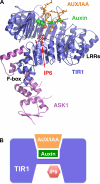Hormone signaling through protein destruction: a lesson from plants
- PMID: 19050175
- PMCID: PMC2645024
- DOI: 10.1152/ajpendo.90807.2008
Hormone signaling through protein destruction: a lesson from plants
Abstract
Ubiquitin-dependent protein degradation has emerged as a major pathway regulating eukaryotic biology. By employing a variety of ubiquitin ligases to target specific cellular proteins, the ubiquitin-proteasome system controls physiological processes in a highly regulated fashion. Recent studies on a plant hormone auxin have unveiled a novel paradigm of signal transduction in which ubiquitin ligases function as hormone receptors. Perceived by the F-box protein subunit of the SCF(TIR1) ubiquitin ligase, auxin directly promotes the recruitment of a family of transcriptional repressors for ubiquitination, thereby activating extensive transcriptional programs. Structural studies have revealed that auxin functions through a "molecular glue" mechanism to enhance protein-protein interactions with the assistance of another small molecule cofactor, inositol hexakisphosphate. Given the extensive repertoire of similar ubiquitin ligases in eukaryotic cells, this novel and widely adopted hormone-signaling mechanism in plants may also exist in other organisms.
Figures


References
-
- Dharmasiri N, Dharmasiri S, Estelle M. The F-box protein TIR1 is an auxin receptor. Nature 435: 441–445, 2005. - PubMed
-
- Dharmasiri N, Dharmasiri S, Jones AM, Estelle M. Auxin action in a cell-free system. Curr Biol 13: 1418–1422, 2003. - PubMed
-
- Dharmasiri N, Dharmasiri S, Weijers D, Lechner E, Yamada M, Hobbie L, Ehrismann JS, Jurgens G, Estelle M. Plant development is regulated by a family of auxin receptor F box proteins. Dev Cell 9: 109–119, 2005. - PubMed
Publication types
MeSH terms
Substances
Grants and funding
LinkOut - more resources
Full Text Sources
Medical

